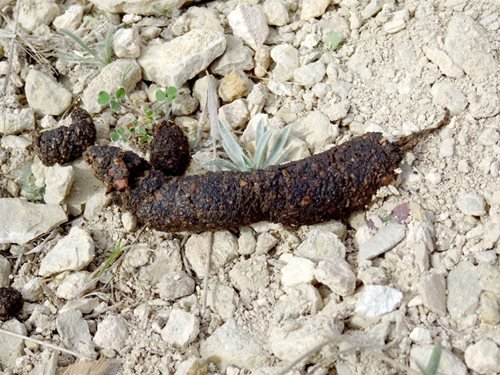Exploring What Skunk Scat Looks Like: A Guide

Skunk scat appears tubular and usually measures about half an inch in diameter. Its color ranges from dark brown to black, often with visible bits of undigested food. When fresh, it emits a pungent, musky odor unique to skunks. Knowing what does skunk scat look like is essential for identifying potential skunk activity in your area. If you stumble upon such droppings, it’s a clear sign that skunks have been around. Let’s delve into more details on how to identify skunk scat and what it can reveal about these elusive creatures.
What Does Skunk Scat Look Like: A Complete Guide
Welcome, curious minds! Today, we are embarking on an exciting journey into the wild world of skunk scat. Have you ever wondered what skunk droppings look like? Well, you’re in the right place! Skunks are fascinating creatures, and their scat can tell us a lot about their diet and habits. So, let’s dive in and explore the mysterious world of skunk scat together!
The Basics of Skunk Scat
Skunk scat, also known as feces or droppings, is the waste material excreted by skunks. It plays a crucial role in the ecosystem as it provides valuable insights into the skunk’s health, diet, and behavior. Identifying skunk scat can help us understand more about these elusive creatures and their presence in our surroundings.
Appearance
Skunk scat can vary in appearance depending on the skunk’s diet and health. Generally, skunk droppings are dark brown to black in color and are around 1-2 inches in length. They often have a twisted or segmented appearance, resembling small cylinders. The texture can range from firm to slightly mushy, depending on what the skunk has been eating.
Size and Shape
Skunk scat is typically cylindrical in shape, with slightly tapered ends. The size of the droppings can vary based on the skunk’s age, size, and diet. Adult skunks tend to produce larger droppings compared to young skunks. The shape of the scat can also indicate the skunk’s health and digestive system functioning.
Identifying Skunk Scat
Now that we know the basic characteristics of skunk scat, let’s delve into how to identify it in the wild. Skunk droppings can often be confused with those of other animals like raccoons or foxes. However, there are a few key features that can help you distinguish skunk scat from others.
Odor
One of the most distinctive features of skunk scat is its odor. Skunk droppings have a strong, musky smell that is similar to the scent produced by skunks when they spray. If you come across scat that has a pungent, offensive odor, it is likely from a skunk.
Contents
Another way to identify skunk scat is by examining its contents. Skunks are omnivores, so their scat may contain a variety of materials like fur, seeds, insects, or plant matter. If you notice these items in the droppings, it is a good indication that they belong to a skunk.
Location
Skunks are nocturnal creatures and are known to establish their territories in specific areas. If you find droppings near burrows, under decks, or along trails, there is a high probability that they are from skunks. Their scat is often found in centralized locations within their territory.
Interpreting Skunk Scat
Skunk scat can reveal valuable information about the skunk’s diet and habits. By observing and interpreting skunk droppings, we can gain insights into what these creatures are feeding on and how they are interacting with their environment.
Dietary Insights
As omnivores, skunks have a varied diet that includes insects, small mammals, fruits, and vegetables. By analyzing the contents of their scat, we can determine what they have been eating recently. If you find seeds or plant matter in the droppings, it indicates that the skunk has been foraging for fruits or vegetables.
Behavioral Clues
Skunk scat can also provide clues about the skunk’s behavior. The location of their droppings can reveal their travel routes, den sites, or feeding grounds. By studying the distribution of skunk scat in an area, researchers can map out the skunk’s movements and habits.
What to Do If You Find Skunk Scat
If you come across skunk scat in your yard or property, there is no need to panic. Skunks are generally shy creatures and are not aggressive unless provoked. However, it is essential to take precautions to prevent skunks from making a home near your vicinity.
Remove Attractants
To deter skunks from frequenting your property, make sure to remove any potential food sources like pet food, garbage, or bird feeders. Skunks are opportunistic feeders, so eliminating attractants can help reduce their presence in your area.
Secure Your Property
Seal off any potential entry points to your home or outbuildings to prevent skunks from seeking shelter. Close off openings under decks or sheds and secure trash cans with tight-fitting lids to discourage skunks from making a den near your residence.
Skunk scat is a fascinating subject that can teach us a lot about these elusive creatures. By understanding what skunk scat looks like and how to identify it, we can gain valuable insights into the world of skunks. Remember to respect these animals from a distance and take necessary precautions if you encounter skunk scat in your surroundings. Happy exploring!
Thank you for joining me on this educational journey into the world of skunk scat. Stay curious and keep exploring the wonders of nature!
What Does Skunk Poop Look Like? Identifying Skunk Feces
Frequently Asked Questions
What are the characteristics of skunk scat?
Skunk scat typically appears elongated and tubular in shape, similar to that of a small dog. It is usually dark brown or black in color and often contains undigested food particles like seeds or insect exoskeletons.
How can you distinguish skunk scat from feces of other animals?
One way to differentiate skunk scat from that of other animals is its distinctive odor, which is pungent and musky. Additionally, skunk scat tends to have a twisted appearance due to the way skunks dig and cover their droppings, unlike the more uniform shape of feces from other creatures.
Where is skunk scat commonly found?
You are likely to come across skunk scat in areas where skunks are active, such as near their den sites, along trails, or in yards and gardens. Keep an eye out for dark-colored droppings with a strong smell in these locations.
Final Thoughts
Skunk scat is typically dark in color and can vary in size depending on what the skunk has been eating. It often contains undigested insect parts, seeds, and fur. When fresh, skunk scat has a strong, musky odor. Remember, identifying what skunk scat looks like can help you determine if skunks are present in your area.







